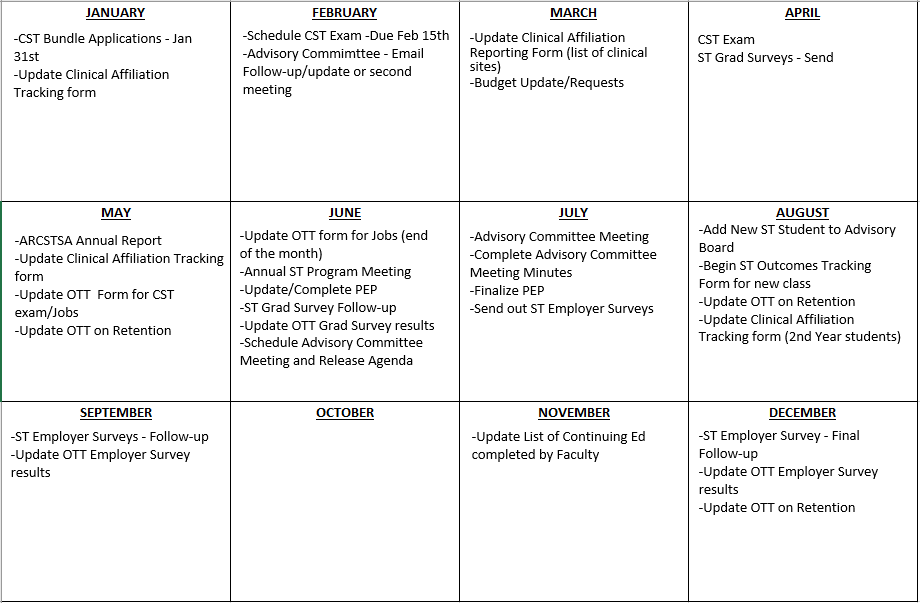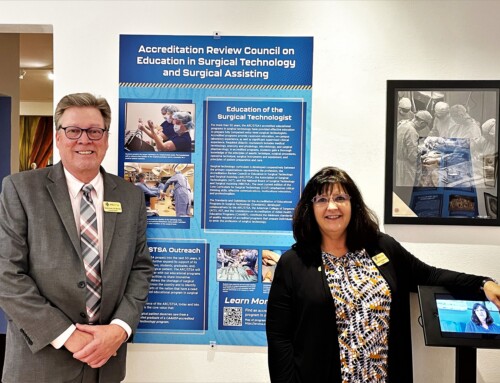By Brenda Poynter, MHA, BSW, CSFA, CST, FAST
Thirteen years ago, I made the decision to transition from working in the operating room to teaching full time with only a year of experience as an adjunct educator. Like most of my colleagues, I came straight out of the clinic with only a fraction of what I needed to succeed. I was taking on the unknown and becoming a program director for two programs, adding an unanticipated administrative aspect to my new job.
Transitioning from the clinic to the classroom has many challenges, but there are a few key tips to survive, and even thrive, those first few years. Staying organized, knowing when to ask for help and learning to say no are all mechanisms that lead to success as a program director.
Yearly Task Calendar: One Tool to Manage a Flexible Schedule
While a flexible schedule in education may appear desirable, it can be a blessing and a curse. We have set times to teach lab or class, but that is not the end of our day. Unspoken hours add up while answering emails, prepping for classes, grading, scheduling tests, surveying students and employers, assessing program outcomes, conducting advisory meetings and more.
I have found that using calendars with schedules for each day, week and month have helped me stay on top of tracking the outcomes necessary to accurately assess a program and continuously improve it. My creation of a yearly task calendar was prompted during one of my first annual reports to ARC/STSA. I was completing the report when I realized I never sent employer surveys for the past year’s class. In a panic, I emailed the form to all the educators and spent several days visiting the hospitals to retrieve results for my report. This incident was the beginning of my administrative task calendar.
Using my newly developed Excel spreadsheet skills, I made a simple calendar and placed reminders for administrative duties to complete each month (pictured below). I included accreditation duties, as well as my annual review for the college, sequencing classes for each semester, ordering books for the classes, planning for special events and so much more. During designated days each month, I work on the tasks listed in the calendar.

An example of a yearly task calendar outlining key events and tasks each month.
Lean on Support From Others
Once you establish your priorities and find a comfortable schedule to manage, never be afraid to say no or delegate tasks when possible. Remember that all tasks need completion, but not always by you.
Empower those assisting with your program by increasing their responsibilities and preparing them for the administrative side of the program in small doses. This will do two things: It will help you complete tasks in a timely manner without being overwhelmed, and it will prepare your staff to eventually step into your role, when the time is right, to keep the program running smoothly during transition.
Staying organized, delegating tasks and saying no are keys to launching and maintaining a successful program. Identifying priorities and using your time wisely will help to keep paperwork up to date and provide structure to the flexibility of a career in education.
 Brenda Poynter, MHA, BSW, CSFA, CST, FAST, has been in the operating room for 34 years. She started as a surgical technologist in the military in 1987 and became a surgical first assistant eight years later. She has been teaching the University of Cincinnati – Clermont College’s surgical technology and surgical assisting programs for the last 13 years and still works PRN at a hospital.
Brenda Poynter, MHA, BSW, CSFA, CST, FAST, has been in the operating room for 34 years. She started as a surgical technologist in the military in 1987 and became a surgical first assistant eight years later. She has been teaching the University of Cincinnati – Clermont College’s surgical technology and surgical assisting programs for the last 13 years and still works PRN at a hospital.



